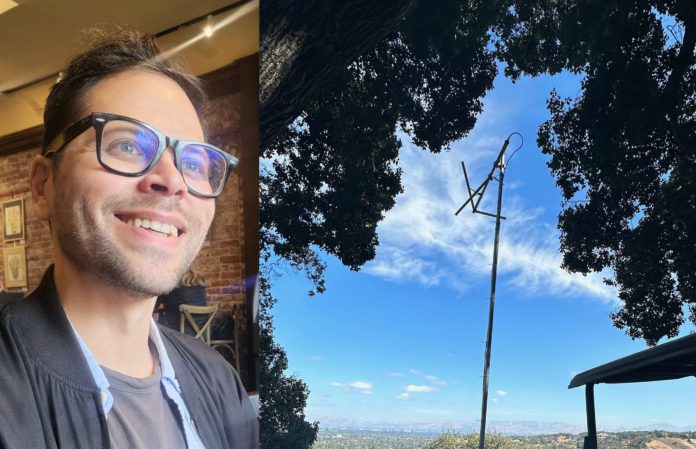
Pirate Cat Radio, at the 92.9 FM frequency, is the “work in progress” of Los Gatos resident Daniel Roberts. KPCR was switched on in 2020 and relocated here this past December, as first reported by the Los Gatan. For Pirate Cat Radio founder Roberts, that move was a homecoming—the culmination of a journey that began in the town of the cats and included stops in San Francisco, Pescadero and Santa Cruz.
In the late 1990s, Roberts—then calling himself Monkey Man—began microbroadcasting at the bottom of the FM dial at 87.9 megahertz from his bedroom in his mother’s Los Gatos home. His antenna was in a tree, and his equipment (purchased from Radio Shack for about $30, plus donated or recycled gear) was under his bed.
One day, the Federal Communication Commission—Roberts refers to them as “men in suits”—dropped in and took possession of his equipment for broadcasting without a full FCC license. The men in suits drove around in a specially equipped van that detected Roberts’ low-watt pirate station.
“I asked the FCC agents if they could show me how they locate unlicensed radio stations, and they offered to take me for a drive to show me,” Roberts said. “I happily jumped in their van and went for an educational ride.”
Among the things he learned: There was a $10,000 daily fine for broadcasting without a license. (And as of 2020, that rate increased to as much as $100,000 per day per violation, with a maximum of $2 million.)
In the 1998 Metro article “Buccaneer Broadcasting,” reporter Jeff Kearns wrote, “Monkey Man is not going to shell out the $10,000 daily fee to the FCC for a broadcast license anytime soon, and even if he did, the FCC won’t license puny little stations under 100 watts.”
Roberts got his start in microbroadcasting at Free-Radio San Jose (93.7 FM).
After that, Roberts says, “I spoke with other radio renegades like Free-Radio Berkeley’s Stephen Dunifer and Dr. Slick from Free-Radio Los Gatos.”
Dr. Slick (who infrequently broadcasted an unlicensed station at 91.3 FM), “helped me understand more about the legalities of broadcasting in the US and about the science behind (radio frequency) engineering,” Roberts says.
‘Here in SV we hear about big tech names, yet equally impactful are the folks who do not get the light of day’
—Daniel Roberts, Pirate Cat Radio founder
It was around this time that Roberts read “Sex and Broadcasting: A Handbook on Starting a Radio Station for the Community.” The author, Lorenzo W. Milam, became Roberts’ hero. Milam offered practical instructions (the word “sex” was just to attract attention) and tales from his experience of creating KTAO (95.3 FM), the first community radio station in Los Gatos.
Less than one year after launching his own pirate station, Roberts went from broadcasting one watt to a wattage ranging between five and 30. The broadcasts could be heard from Sunnyvale to the Highway 17 summit.
“I also became a hero of local commercial broadcast engineers from Clear Channel and Entercom (two large broadcast groups), who not only taught me more about the legalities and commercial side of the radio business but also donated old equipment from KFOG, KSJO and others,” said Roberts.
Roberts later sailed his pirate station to other waters, spending some time in Hollywood, according to an LA Weekly article from 2002, as well as in San Francisco and at a tiny licensed station in the San Mateo County coastal hamlet of Pescadero.
Over the years, in his dealings with the FCC, Roberts used a specific federal provision from 1944 that protected unlicensed stations during wartime.
In the early 2000s, when Roberts was operating a station in San Francisco, he argued that the loophole applied during President George W. Bush’s “War on Terror.”
But a lot has changed since 1944. The Telecommunications Act of 1996, signed by former President Bill Clinton, allows large syndicated radio stations to purchase individual local community nonprofit stations.
According to the FCC, “The Telecommunications Act of 1996 is the first major overhaul of telecommunications law in almost 62 years. The goal of this new law is to let anyone enter any communications business—to let any communications business compete in any market against any other.”
The act affected not only radio but also telephone service, cable programming, broadcast services and education.

Back in 1998, Roberts told Metro that San Jose, Santa Cruz and Berkeley had popular pirate radio sites, and that there were likely between 500 to 700 stations in California operating with more than one watt. In 2000, SF Gate wrote, “The Bay Area is the capital of pirate radio stations—low-power, unlicensed stops on the FM dial—and now they’re leading the rebellion against corporate giants of the airwaves, lawyers and raids by the FCC.”
Fast forward to 2020 when the Preventing Illegal Radio Abuse Through Enforcement (PIRATE) Act was signed into law. This law requires the FCC to sweep for pirate stations annually within the five most active markets: New York, New Jersey, Florida, Pennsylvania and Maryland.
The FCC maintains a Pirate Radio Enforcement Action database, and California hasn’t made the cut for “enforceable action” since 2020.
Since the Telecommunications Act of 1996 became law, America’s radio culture has become much more monochromatic.
National conglomerates now control and broadcast national content using the former nonprofit stations they purchased in the Bay Area and across the country. For example, San Francisco broadcast license KEXC sold for $3.75 million. And the frequency and call letters may be changed at the discretion of the FCC. Its call letters—now KEXP—and frequency were sold to Washington State University in Seattle.
Conservative Christian syndicates have taken over local nonprofit and locally owned stations. KUSP, the longtime public radio station in Santa Cruz County, was picked up at auction in 2016 for $605,000 by Educational Media Foundation, a Christian radio conglomerate.
The same takeover happened to Los Gatos-based KRTY, a country music station that was one of the last locally owned stations in the Bay Area. The license for this frequency was also purchased by the Education Media Foundation—also known as KLOVE.
Roberts urges any would-be broadcasting buccaneers to take note that it is illegal to buy or ship radio transmission equipment, and that it would be foolish to “think that they are able to broadcast without approval from the FCC.
“My advice is to reconsider, as the FCC fines are $2 million now versus the $10,000 it was prior to 1996,” Roberts says, further suggesting that the agency doesn’t have a sense of humor or forgiveness.
Commercial radio stations can broadcast a signal of one watt to well over 100,000 watts, depending on its license. Pirate Cat Radio (KPCR 92.9FM) now broadcasts at 100 watts—with the full blessing of the FCC, as it’s under an LPFM license (Low Power Frequency Modulation).
‘Everyone has a voice here’
—Daniel Roberts, KPCR founder
Marauding pirates are helping others find a way to be heard, becoming voices for those unable to speak for themselves. Now Roberts is in a position to help nonprofits and communities to broadcast.
Through the magic of radio, KPCR 92.9 offers a platform to film directors, book authors, local alternative musicians, underground artists and societal misfits. “Tune in—everyone has a voice here,” Roberts says.
KPCR does public service announcements to promote services and events offered by nonprofits and community organizations, such as the Los Gatos Music Boosters, which helps K-12 have access to musical education, and the Los Gatos Anti-Racism Coalition.
Roberts is actively recruiting new volunteers and radio hosts, as well as local businesses that may have marketing budgets and could become sponsors.
In Los Gatos, residents are already fortunate enough to have live music at coffee shops, bars, sidewalks, alleyways, parks, farmers markets and restaurants. And now it has its own radio station to share with Silicon Valley. Roberts’ childhood dream is becoming a reality.
“I want people not to just hear a lot of miscreants on the air, something raw and straightforward,” he says. “Here in SV we hear about big tech names, yet equally impactful are the folks who do not get the light of day.”
Roberts’ journey took him from pirate to engaged community member. He reiterates this advice:
“Do not go pirate—it is a struggle and it could be very expensive. Send in what you wish to program, and we will fit you into a slot to broadcast over KPCR.”
Pirate Cat’s Programming
I Want You to Know…
Host: Nero Nava
Schedule: Tuesdays at 5pm
Description: Nero Nava interviews various guests, from artists and archivists to taste-makers and activists. These interviews are sandwiched between songs selected by the guest and Nero himself. By getting to know his guests through their music and stories, Nero invites listeners to know themselves better.
Salt Lake Dirt
Host: Kyler Bingham
Schedule: Mondays at 6pm
Description: Kyler Bingham focuses on the creative process and how artists find inspiration. In each interview, guests discuss their work, influences and thoughts, providing listeners with a behind-the-scenes look at the work of contemporary artists.
ANNOYED
Host: Susan Maleta
Schedule: Tuesdays at 8pm
Description: Susan delves into her most infuriating pet peeves and explores mind-blowing articles on anger management. She also sits down with local comedians to discover their biggest annoyances and how they conquer them with epic humor and wit.
Frequency Horizon
Host: Drew Penner
Schedule: Fridays at 10pm
Description: Listeners can immerse themselves in the pulsating beats of electronic music and the vibrant surf culture with captivating interviews, mind-blowing mini-docs, and heart-pounding DJ mixes.
In Defense of Ska
Host: Aaron Carnes
Schedule: Fridays at 5pm
Description: Aaron Carnes and Adam Davis defend ska music, proving that it’s just as valid and worthy of respect as any other genre.
Re&Co Radio with Jurgis Didžiulis
Host: Jurgis Didžiulis
Wednesdays at 5pm
Description: Jurgis Didžiulis invites different guests to join him in discussion and musical exploration, diving deep into topics related to regeneration while co-creating original music inspired by their conversations.
Programs not played on other stations or very few:
Ukrainecast
Schedule: Every morning at 8am
Description: Ukrainecast provides the latest from the Russian invasion of Ukraine, daily.
Native America Calling
Schedule: Weekday mornings at 10am
This call-in program generates thought-provoking conversations about issues that are relevant to Indigenous communities. Guests and experts engage with callers throughout the United States about improving the quality of life for Native Americans.
Somewhere in Time: Classic Reruns of Art Bell’s Coast to Coast AM
Schedule: Thursday nights
Some of the best from the late Art Bell, who created the very popular overnight talk radio show.
Drew Penner is the editor of the Los Gatan, and Aaron Carnes is Metro’s calendar editor. —Editor
(A version of this story also appeared in Metro Silicon Valley.)










